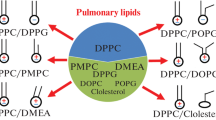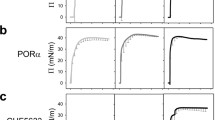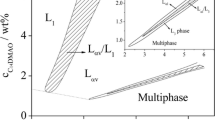Abstract.
Aqueous dispersions of a porcine lung surfactant (PLS) extract with and without cholesterol supplementation were analyzed by X-ray scattering. Lamellar liquid-crystalline and gel-type bilayer phases are formed, as in pure phosphatidylcholine (PC)-cholesterol systems. This PLS extract, developed for clinical applications, has a cholesterol content of less than 1% (w/w). Above the limit of swelling, the bilayer structure shows a melting (main) transition during heating at about 34 °C. When 13 mol% cholesterol was added to PLS, so that the cholesterol content of natural lung surfactant was reached, the X-ray scattering pattern showed pronounced changes. The main transition temperature was reduced to the range 20–25 °C, whereas according to earlier studies of disaturated PC-cholesterol bilayers in water the main transition remains almost constant when the amount of solubilized cholesterol is increased. Furthermore, the changes in scattering pattern at passing this transition in PLS-cholesterol samples were much smaller than at the same transition in PLS samples. These effects of cholesterol solubilization can be related to phase segregation within the bilayers, known from pure PC-cholesterol systems. One phase, solubilizing about 8 mol% cholesterol, exhibits a melting transition, whereas the other bilayer phase, with a liquid-crystalline disordered conformation, has a cholesterol content in the range 20–30 mol% and this phase shows no thermal transition. The relative amount of bilayer lipids that is transformed at the main transition in the PLS-cholesterol sample is therefore only half compared to that in PLS samples. The reduction in transition temperature in the segregated bilayer of lung surfactant lipids is probably an effect of enrichment of disaturated PC species in the phase, which is poor in cholesterol. This work indicates that cholesterol in lung surfactant regulates the crystallization behavior.
Similar content being viewed by others
Author information
Authors and Affiliations
Additional information
Electronic Publication
Rights and permissions
About this article
Cite this article
Larsson, M., Larsson, K., Nylander, T. et al. The bilayer melting transition in lung surfactant bilayers: the role of cholesterol. Eur Biophys J 31, 633–636 (2003). https://doi.org/10.1007/s00249-002-0256-9
Received:
Revised:
Accepted:
Issue Date:
DOI: https://doi.org/10.1007/s00249-002-0256-9




